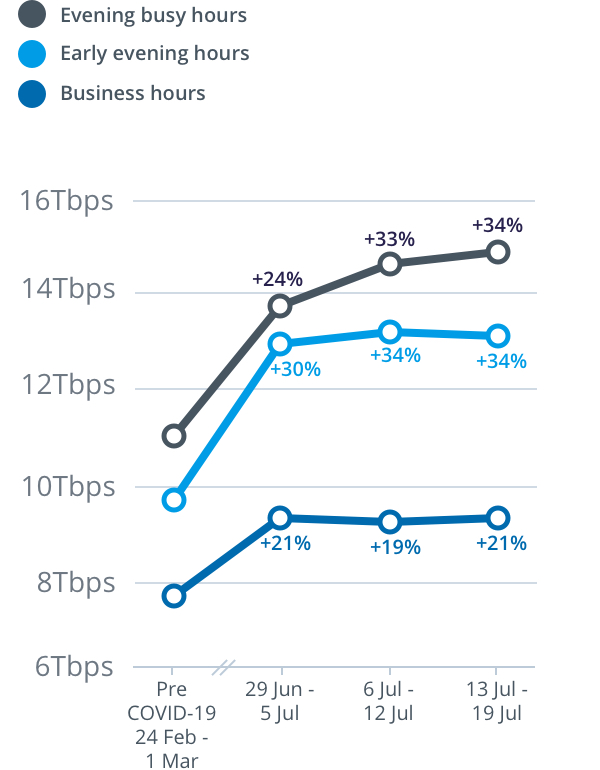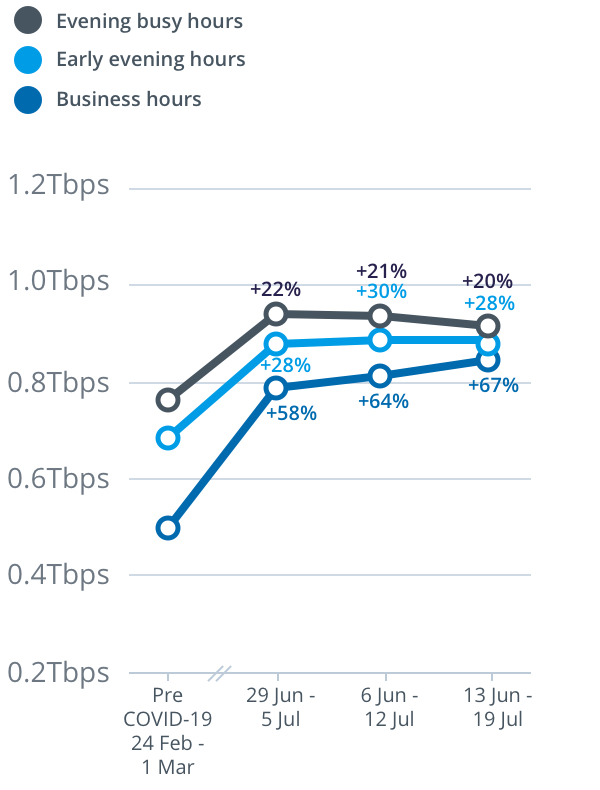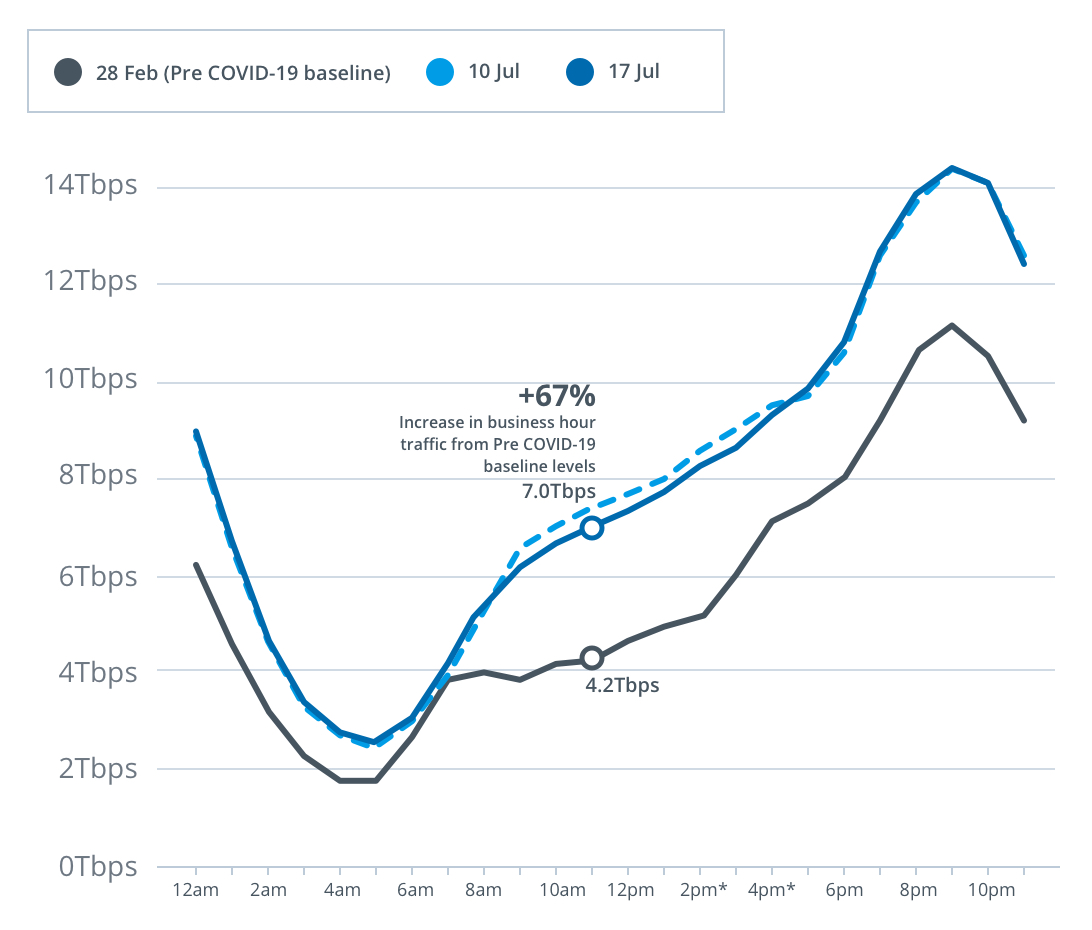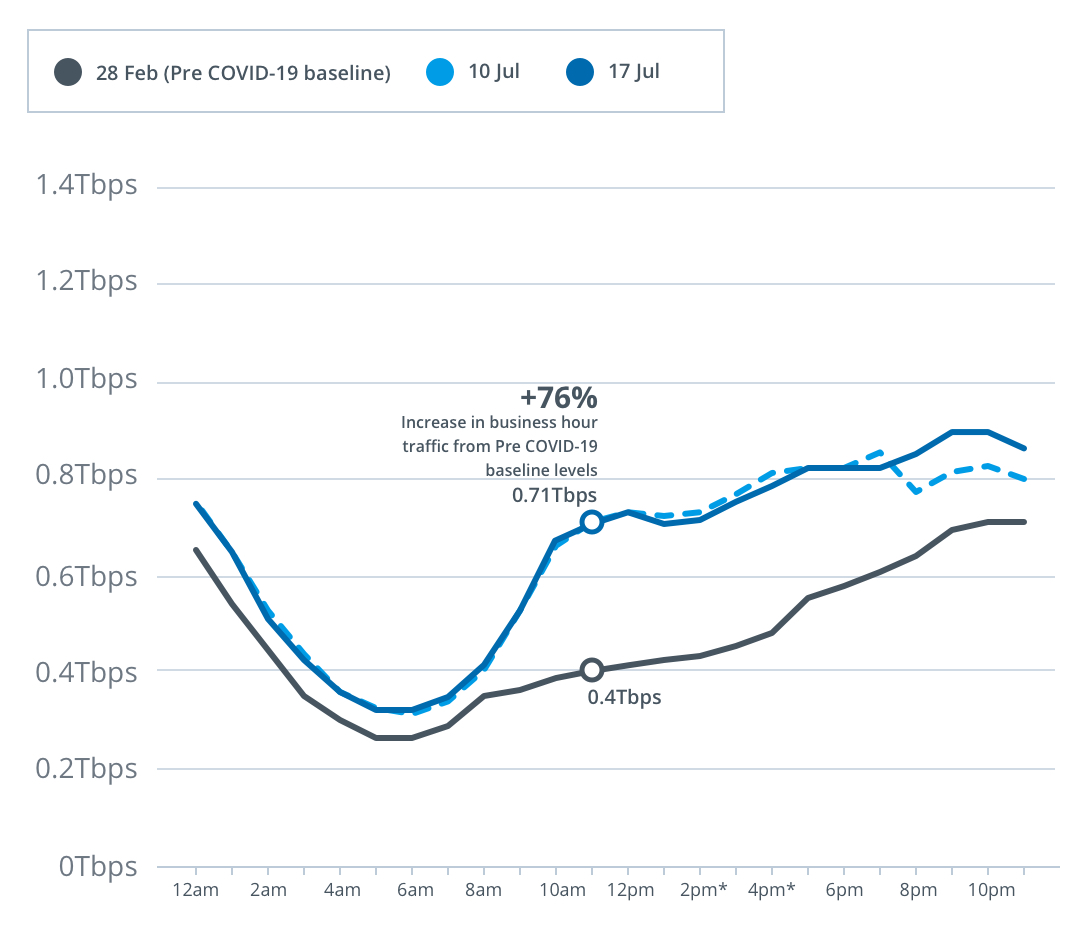NBN Co moves to support increased data demand, extends additional capacity offer to internet retailers
- NBN Co offers pricing relief for increased network capacity requirements of up to 40 per cent (where available, depending on access technology) to internet retailers, based on the February 2020 baseline, at no extra cost until 19 September 2020
- Almost $80 million worth of credits provided to participating internet retailers to date since the start of the extra capacity campaign
- Provides four weeks’ extra time for internet retailers to adjust to national growth in data demand and provision their capacity accordingly
- Australian Broadband Data Demand report highlights on the main nbn wholesale service:
- Weekly download throughput peak of 14.8 Terabits per second (Tbps) recorded on Saturday, 18 July during the evening busy hours
- Weekly upload throughput peak of 0.92 Tbps recorded on Monday, 13 July during the evening busy hours
NBN Co has again extended its offer to provide internet retailers with a credit to offset increases in certain wholesale capacity charges up to 40 per cent (where available, depending on access technology), based on the pre-COVID-19 February baseline, at no extra cost until 19 September 2020. The additional capacity offer was due to expire on 19 August 2020 and will now expire on 19 September at which time it will be withdrawn.
NBN Co has also extended its offer to increase the fair use thresholds for its standard Sky Muster satellite service to 90GB* of data on average until 30 September 2020. This offer, which came into effect at the end of March, adds 45GB* to the applicable fair use threshold for each standard Sky Muster service at no additional cost to internet retailers.
The additional capacity offers have resulted in NBN Co providing almost $80 million so far in financial relief credit to participating internet retailers to help support increased levels of data use during COVID-19. NBN Co will extend these offers in accordance with current terms, which means that participating internet retailers will receive pricing relief on nbn bundled discount plans until 19 September 2020, and for standard Sky Muster satellite services until 30 September 2020.
NBN Co’s initial capacity offer was launched in March 2020 to give internet retailers pricing relief for up to 40 per cent more Connectivity Virtual Circuit (CVC) capacity, where available and required, to respond to increased COVID-19 related user demand.
Brad Whitcomb, Chief Customer Officer, said: “This is the right thing to do. We trust the data capacity initiative will first and foremost support Australians’ heightened need for secure, high-speed access to broadband services at this critical time and, secondly, help give internet retailers the time and financial relief they need to adapt to their customers’ changing data demands.
“It is also important to recognise that the underlying annual growth in data demand has maintained a consistent trajectory, and it is this sustained growth, aside from any COVID-19 related impact, that requires a long-term, well-considered, industry-wide response.”
NBN Co today confirmed that its network continues to perform extremely well under the increased demands during the COVID-19 pandemic of more people spending more time working, learning, gaming and streaming entertainment at home.
For the week from Monday 13 July to Sunday 19 July, peak download throughput (the measure of data flowing through the nbn™ network) during the busy evening period increased by 34 per cent to a new record peak of 14.8 Terabits per second (Tbps) on the main nbn wholesale service, compared to the last week of February (which nbn measures as its normal pre-COVID-19 baseline).
Brad Whitcomb said: “The record peak that occurred last Saturday night coincided with 89 per cent concurrent usage across nbn-connected homes in Melbourne.”
Peak download throughput during the same week also increased during daytime business hours, up 21 per cent to 9.4Tbps, and early evening hours up 34 per cent to 13.1Tbps, compared to the pre-COVID-19 baseline.
NBN Co has revealed a complex picture of the key drivers of increased data demand that it says needs to be factored into internet retailers’ future capacity procurement strategies. Much of the growth in demand has occurred due to new customers and normal, organic growth in data demand across the entire customer base.
For example, since March 2020, there have been more than 600,000 new premises connected to a plan over the national broadband network, representing an 8 per cent increase in nbn’s customer base to 7.5 million activated premises.
Australian Broadband Data Demand is a report produced by NBN Co showing the peak weekly throughput during daytime business hours, early evening hours and busy evening hours.
Downstream network usage

Upstream network usage

Downstream network usage over 24 hours

* The “Downstream network usage” graph in the week of 6 July - 12 July has been calculated using an estimate for the 2pm, 3pm and 4pm readings for Friday 10 July. This is due to a network incident which meant that actual network traffic usage was not captured during that time at a particular Serving Area Module. nbn has generated the estimates using the hourly growth rates from Friday 3 July at 2pm, 3pm and 4pm, and applied those growth rates to the 1pm readings for Friday 10 July. Please treat these graphs with caution when using them for comparison purposes.
Upstream network usage on the nbn™ main wholesale service during business hours on 17 July 2020 was 76 per cent higher (as shown in the graph below at 11am) than the pre-COVID-19 baseline.
Upstream network usage over 24 hours

* The “Upstream network usage” graph in the week of 6 July - 12 July has been calculated using an estimate for the 2pm, 3pm and 4pm readings for Friday 10 July. This is due to a network incident which meant that actual network traffic usage was not captured during that time at a particular Serving Area Module. nbn has generated the estimates using the hourly growth rates from Friday 3 July at 2pm, 3pm and 4pm, and applied those growth rates to the 1pm readings for Friday 10 July. Please treat these graphs with caution when using them for comparison purposes.
The Australian Broadband Data Demand report is updated weekly on nbn’s Transparency dashboard at: www.nbn.com.au/updates
For tips on how to make the most of your nbn connection and to learn more on what NBN Co is doing to support Australia through COVID-19, please visit: www.nbnco.com.au/campaigns/covid-19
Notes to editor:
- These metrics represent the upstream/downstream throughput peak each week, across the following three distinct periods:
- Business hours - Monday to Friday 8am to 4:59pm
- Early evening hours - Monday to Sunday 5pm to 7:59pm
- Evening busy hours - Monday to Sunday 8pm to 11:59pm
- For Business Hours, the peak is determined by taking the highest downstream throughput for our TC-4 service from the busiest 15-minute increment for downstream throughput, and from the busiest 30-minute increment for upstream, between Monday to Friday. The Early Evening Hours and Busy Evening Hours figures are recorded using the same methodology, but over a seven-day period.
- TC-4 is nbn’s standard wholesale broadband service that is designed primarily for general internet and standard data services across all access technologies.
- NBN Co considers the throughput peak metric for our TC-4 service as the most appropriate measure for growth in data flowing through the network as it shows when network use is at its highest in each defined period in a week for our wholesale access service most used for residential broadband services.
- This graph shows TC-4 usage (measured in terabits per second for both upstream and downstream) over a 24-hour period (using Australian Eastern Standard/Daylight time on the dates shown in the key). It compares the results from those two dates against a corresponding 24-hour period from nbn’s pre-COVID-19 baseline on 28 February 2020 (the last week of February). Each marker on the x axis represents an hour period in the day. The y axis shows, for each of the 60-minute periods in that 24-hour period:
- The downstream throughput measure calculated by recording the highest downstream throughput for our TC-4 service from the busiest 15-minute increment in that 60-minute period.
- The upstream throughput measure calculated by recording the highest upstream throughput for our TC-4 service from the busiest 30-minute increment in that 60-minute period.
- The terabits per second (Tbps) value is rounded to one decimal place. The percentage increase is rounded to the nearest whole number.
- *nbn intends to engage with retail service providers and review demand on the nbn™ Sky Muster™ service following the data increase on a monthly basis and adjust the appropriate level of allocation if required.
Media enquiries
Greg Spears
Phone: +61 406 315 014
Email: gregspears@nbnco.com.au
NBN Co Media Hotline
Phone: 02 9927 4200
Email: media@nbnco.com.au

